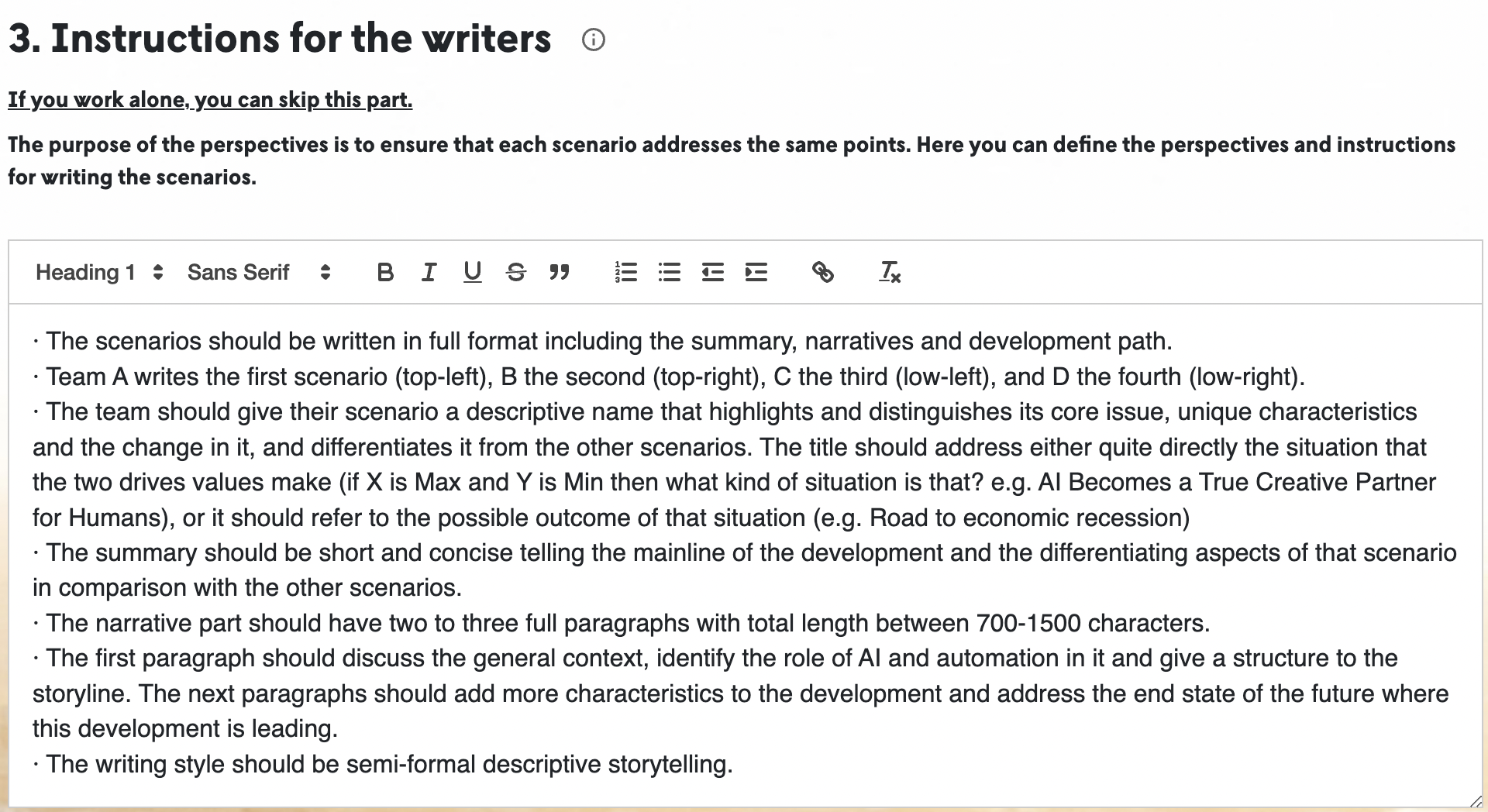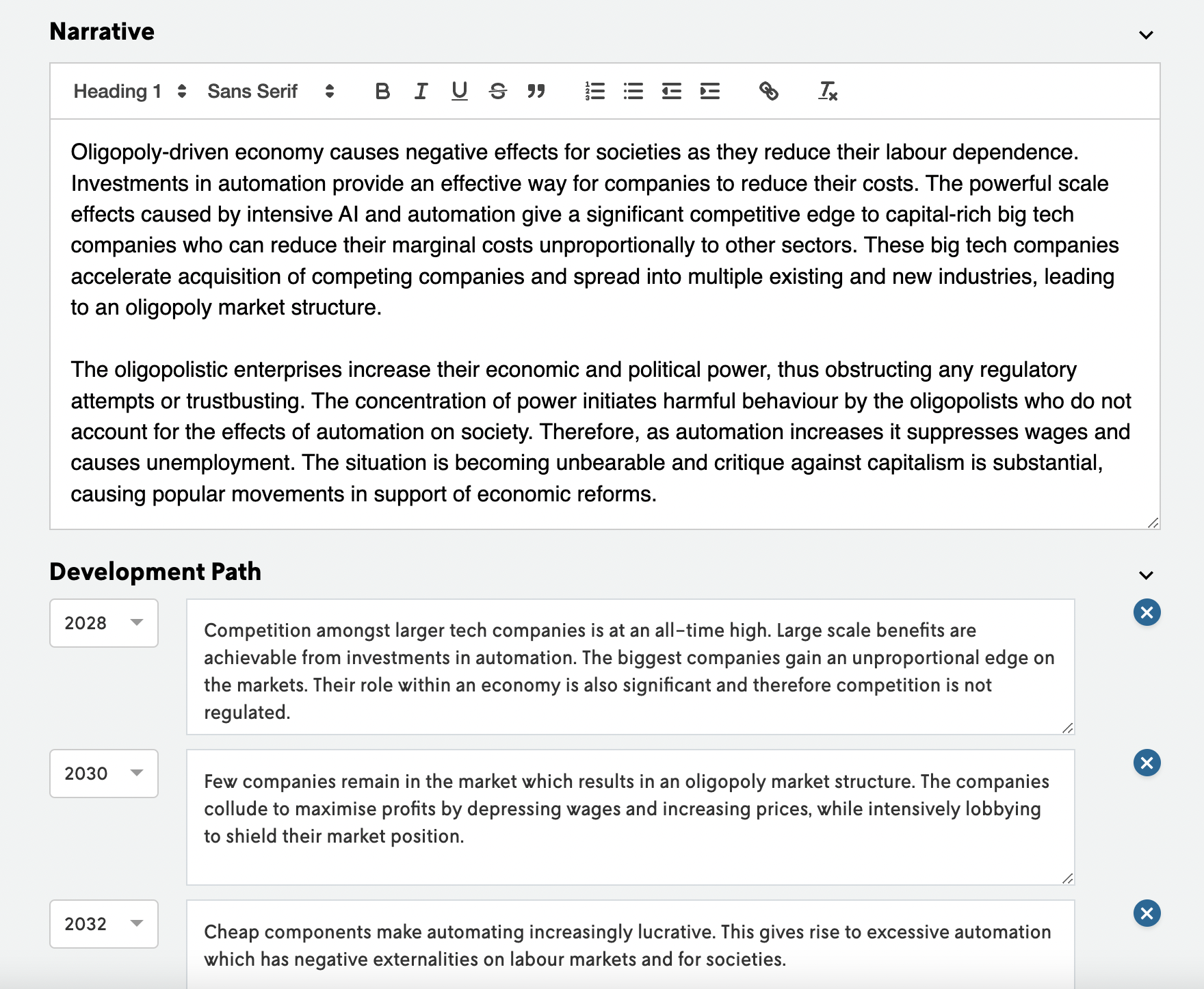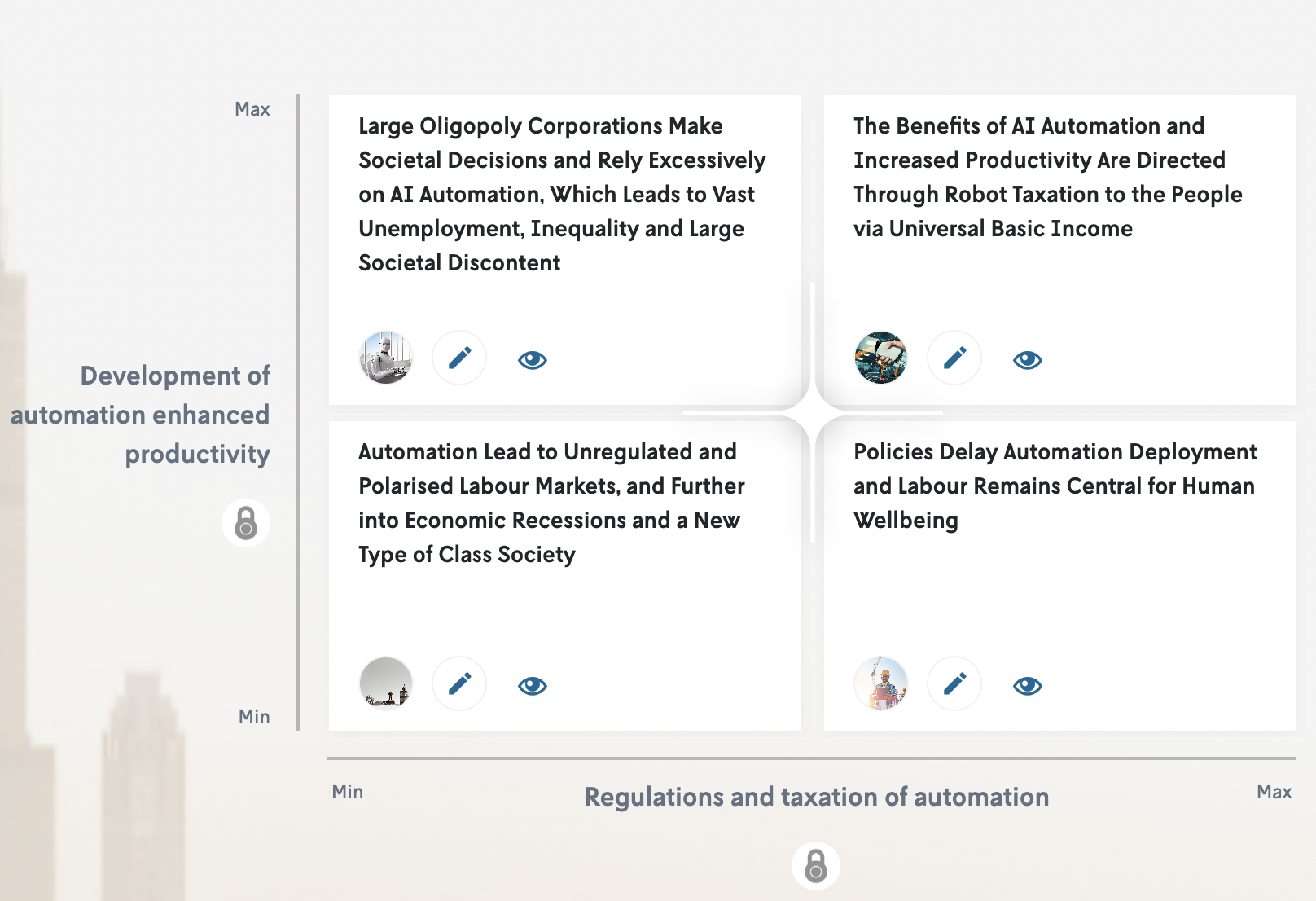In this article, we will help you excel in our scenario tool with four simple steps.
Read more about why to build scenarios and have a look at an example of the process. If you wish to read more about how to utilise and monitor the created scenarios, jump right to the end of this article.
Step 1: Choosing the topic
Formulating a clear topic is a crucial first step in your scenario-building process, as it not only establishes a mutual understanding between project facilitators and participants but also acts as a reminder of the research focus.
For example, if you want to know where and how you should invest in San Francisco real estate in 2030, a good title could be "Investment in San Francisco real estate in 2030." Pinpointing a location and time in the topic helps frame your thoughts on the future possibilities of your specific area of interest. It will also help ensure that the end work strongly reflects your context and brings out the answers you look for in your analysis.

An example of a scenario work topic.
Step 2: Naming the two drivers of uncertainty (X and Y axes)
This is the most crucial and difficult step since it will steer the direction of the four scenarios you will create.
In the 2x2 (Drivers of uncertainty) method, you should choose 2 drivers that can have meaningful MIN and MAX values. The names of the vertical and horizontal axes should come from what you identify as the most influential and uncertain drivers of the topic.
Before deciding on the drivers, we advise you to test some variations first. You can list, e.g., 10 drivers that can be used as axes in your topic. Try how different combinations work together. The first drivers that come to your mind may not always produce the best four alternatives for the topic.
A good set of drivers approaches the topic from different angles. For example, one driver may approach the issue from the point of view of technological change and the other from the value side, or the first from finance and the other from a chronological time perspective.
Once you have chosen a relevant combo of two drivers, you should fine-tune both to make them fully functional axes with maximum and minimum values. To do so, we suggest using words that imply a direction, dynamic or degree of change in the chosen drivers (i.e., increasing x, the rise of x, and the amount of x).
In the example “Investment in San Francisco real estate in 2030”, the hypothetical drivers in the vertical and horizontal axes can be "Increase in foreign immigration" (as X axis) and "Rise of the number of US residents who desire to own property in San Francisco" (as Y axis), respectively.
Hence, an axis shouldn’t be a general theme like agriculture or the future of work, to which one could give dozens of varying states, such as robotised vs. productive, or remote work vs. automation. Instead, an axis should introduce a clear scale on a well-defined change, act, quality or characteristic.
Examples:
No: Color: Black – Orange
Yes: Colorfulness in Orange–Black scale: Min (satin black) – Max (bright orange)
No: Agriculture: Robotised – Productive
Yes: Robotisation of agriculture: Min (same as today) – Max (huge increase)
Tip: If you have not selected or find it hard to identify two distinguished key drivers, you can do horizon scanning on Futures Platform by creating a foresight radar. On that radar, rate the likelihood/uncertainty and impacts of all phenomena. When the rating is done, you will be able to identify phenomena with the highest impact and likelihood/uncertainty regarding your topic. You can use these as the axes in your scenario matrix. Read the "Scenarios - How to?" -chapter in this article if you wish to learn more about the steps before scenario building.

An example of scenario work axes.
Step 3: Defining the perspectives and instructions for writing the scenarios
If you work alone, you can skip this step.
The purpose of step 3 is to define the common perspectives and instructions for the scenarios that will be created in step 4. If you are working alone, you can use this section as a checklist for writing the scenarios.
The purpose of defining perspectives is to ensure comparability among scenarios. The perspectives guide the participants in the scenario-building process by framing the angles from which the scenarios should be written. For example, each scenario could describe the future from an economic and social point of view or explain what kind of customer needs and competition will emerge.
Clearly indicate whether you want to write only short summaries for each of the four scenarios or build complete scenarios with narratives and development paths. If you aim for complete scenarios, it is important to indicate the number and the order of the paragraphs, the wished length of the narrative text, the number of the needed development path events in each scenario, and the style of the images that you may want to add to the scenarios. You may also want to define a specific ‘house style’ for scenario writing.
Providing clear instructions is essential to ensure the quality of scenario results and, therefore, their usability when integrated into strategy and roadmap development. However, it’s important that the instructions don’t constrain the creativity or imagination of scenario builders. Creative ideas should be encouraged as they enable participants to look beyond obvious scenarios and uncover possible unexpected changes. Avoid limiting instructions such as "Please align with our current strategies" or "Do not go beyond our yearly plan".
Additionally, we advise you to also provide a scenario example to guide the participants in their scenario-building process. A concrete example can effectively communicate instructions and serve as a useful reference point.
The instructions for the participating writers can also be used to define who/which subgroup should write the narrative of scenario 1 (top-left corner), and who should do the second scenario (top-right corner), and so on. Yet, this division of work can of course be agreed elsewhere before or after you begin the process.

Step 4: Writing the scenario texts
After clicking the "Save and activate" button, you’ll enter the scenario-building page, where you’ll see the 2x2 matrix with two axes showing maximum and minimum values at the end of each side. These values refer to the development of the drivers, and each scenario represents a different combination of them.
By clicking the pencil icon, you’ll access that particular scenario’s editor. There, you’ll first see a grey box with "Drivers used in this scenario analysis," where the chosen drivers will have their designated values. For example, the first driver may have a minimum value and the other a maximum value. This will serve as the key guideline for building the scenario. You should consider that specific situation when formulating your general perspective on that scenario. Each of the three other scenarios has different driver values in their grey boxes.
For example, in a scenario where the X axis "Increase in foreign immigration" has a minimum value and the Y axis "Rise of the number of US residents who desire to own property in San Francisco" has a maximum value, the narrative text may look like this: “The level of foreign immigration in San Francisco remains the same as the present, while the number of US residents who desire to own property in San Francisco reaches a new record high, or becomes unimaginably high.”
Next, if you have decided to build short scenarios with only the title and summary sections, follow Steps 4.1 (Title), 4.2 (Summary), and 4.5 (Add-ons) below.
Alternatively, if you have decided to build full scenario narratives with development paths, follow the below instructions in full. Follow the instructions in this order: Step 4.1 Title > Step 4.3 Narrative > Step 4.4 Development Path > Step 4.2 Summary > Step 4.5 Add-Ons.
Step 4.1 Title
Each scenario should be given a descriptive name that highlights and distinguishes its core issue, unique characteristics and the change in it, and also differentiates it from the other scenarios. The title should address either quite directly the situation that the two drives values make (if X is Max and Y is Min then what kind of situation is that? e.g. AI Becomes a True Creative Partner for Humans), or it should refer to the possible outcome of that situation (e.g. Road to economic recession).
Step 4.2 Summary
The Summary section provides an overview of the key changes in the scenario. It is recommended to write the summary in a single concise paragraph instead of a bullet point list. The summary should address at least these three points:
- What the world or context looks like in this particular scenario
- How things could roughly play out within the given situation
- How it will impact your organisation, or what actions your organisation should take
Step 4.3 Narrative
If brief scenarios don’t satisfy your strategic needs and you want to develop full-scale scenarios, it’s advisable to build a narrative for each scenario. Here, you can elaborate more on various perspectives on how each scenario could play out, detailing the business opportunities, customer personas, behaviours of relevant institutions and competitors, and other threats that might endanger your organisation in the given scenario.
The ‘Scenario narrative’ section consists of multiple paragraphs that collectively provide a more comprehensive analysis of your research question. Each paragraph should focus on a different perspective related to the topic. To ensure an effective structure, determine the number of paragraphs needed in your scenarios, their optimal lengths, and the order in which the perspectives are discussed. These perspectives can include, e.g. the general context, economic developments, technological developments, sociocultural developments, competitor actions, impacts on our organisation, and more.
The purpose of defining perspectives is to ensure comparability among scenarios, especially if there is more than one writer. The perspectives guide the participants in the scenario-building process by framing the angles from which the scenarios should be written. For example, each scenario could describe the future from an economic and social point of view or explain what kind of customer needs and competition will emerge.
When writing a narrative, follow the 5C1P (Clear, Concise, Coherent, Concrete, Complete, and Plausible) principles.
Step 4.4 Development path
Next, you can formulate a development path based on the overall ideas presented in your scenario narrative. Consider the series of events that need to happen for your scenario to become a reality and map out the timeline (or vice versa). When listing the sequence of events, focus on the interrelations between the key drivers you’ve identified. The resulting development path and timeline will serve as key indicators for monitoring the future development of your scenario.
Below is an example development path and timeline of a scenario where the level of foreign immigration in San Francisco remains the same, while the number of US residents seeking to own property in the city reaches an all-time high:
2025: Increasing number of foreign companies seek to relocate to Silicon Valley due to its research and development advantages, while local companies mostly relocate to other states to reduce costs.
2028: The local government tries to attract American investors to purchase more land in San Francisco by offering tax waivers to its citizens.
Caution! When mapping out a development path and timeline, it's important to avoid developing another scenario within a scenario. A clear description of each event within the timeline typically requires only 2-3 sentences, highlighting a few key actors. The more wordy the descriptions become, the more potential there is for confusion. Hence, in case you see many events taking place during the same year, it is advisable to split these into separate events.
Step 4.5 Add-ons: images and tags
After completing the scenario writing process, it’s time to add images and industry tags to each scenario.
Decide if you want to add images to your scenarios. Adding images helps convey your scenario in a visual format, which may help illustrate the key points and differences between the scenarios.
Adding tags helps contextualise your scenario and highlight its linkages to different industries, threats, opportunities, innovations, and other relevant categories. This can benefit your organisation, particularly if diversification or decision impact assessment is on the agenda.

An example of a scenario narrative and development path.
Final remarks
When your first scenario is ready, simply repeat the same process with the remaining three scenarios. Once you've completed all four scenarios using these steps, you're done and ready to go!
Facilitators should review the final scenarios to ensure the narrative structure and style are aligned across all scenarios.
In case you have limited time, e.g. in a workshop, you can revisit and finish the narrative and development path parts later. Nevertheless, make sure to brainstorm ideas with your team during this stage, especially if scenario building is a group effort. The ideas you come up with will assist you in developing a comprehensive scenario.
After the scenarios have been filled in and saved, you can find the scenario cards on the Scenarios-tab of your Scenarios-page.
How to utilise and monitor the scenarios?
We’d like to share a few tips that will help you effectively integrate your scenarios into your organisational strategies.
Tip 1: Stress test your strategy
The purpose of doing a stress test is to evaluate the robustness of your current strategy. As a first step, summarise how your strategy “positions your company" and its “action plan" into a couple of sentences. Next, use the what-if framework below to assess the impacts of each scenario on the strategy. For each impact, provide a description and a score, where a negative impact is -1, a neutral impact is 0, and a positive impact is 1. Select the scenarios that could potentially challenge the existing strategy and list the key challenges, as shown in the table below.
|
What
|
If |
If |
|
Scenario A: Foreign immigration in San Francisco does not change from the present and the number of US residents who desire to own property in San Francisco hits new highs |
Scenario B: Foreign immigration in San Francisco increases significantly but US residents don’t want to own property in San Francisco |
|
|
“Continues investing in San Francisco rental houses and apartment businesses” |
Impact A1 |
Impact B1 |
|
Impact A2 |
Impact B2 |
|
|
Impact A3 |
Impact B3 |
|
|
Total score |
-2 |
0 |
Once you've completed all impact descriptions for each scenario and calculated their total score, review the results to gain an understanding of the overall situation and identify any potential vulnerabilities in your current strategy. Consider questions such as: "Do we need to modify our strategy in response to different scenarios? If so, how?" "What are the winning strategic options for each scenario?" and "How can we leverage the impacts outlined in each scenario narrative to benefit our organisation?”
Tip 2: Monitor scenarios and your strategy
Enlisting a person or team to monitor your scenarios can help you stay up-to-date and respond promptly to the latest developments.
A good starting point is to identify the phenomena with the highest impact and uncertainty regarding your core strategies on Futures Platform’s foresight database and periodically scan the latest news on these phenomena cards. You can find the newsfeeds at the bottom of each card.
You can also use our curated news search feature located on the "content explorer" page. Simply enter relevant keywords and find the latest future-focused news articles related to your scenario topic.
Our bi-weekly Disruptor Alert is another valuable resource that you can utilise to monitor the development of your scenarios. It features the latest news with disruptive potential on your chosen themes, handpicked by our team of futurists. Make sure to check it out regularly and assess whether any changes have the potential to affect your scenarios or strategic work.
We strongly recommend to fully utilise all the news feed functions on our platform at least once a month. Doing so can significantly enhance the foresight capability of your team and empower your strategic direction.
Tip 3: Recheck the 4 points below, especially if you are a facilitator
- Ensure that each step of the process is described in detail and concisely. You can do that by putting yourself in the participant's shoes and thinking about how you would execute the task.
- Assemble a diverse team that involves key decision-makers to collaborate on scenario building.
- When conducting a scenario-building workshop virtually, use an interactive platform (i.e., Zoom, Teams, or Google Meet) to connect participants. This will promote open discussion and foster collaborative teamwork.
- After the scenarios are ready, hold follow-up discussions to expand on the ideas generated. We recommend arranging these meetings 2-4 times a year.
Note: Our 2x2 Scenario Builder always generates four different scenarios derived from the two most critical drivers. This approach is designed to provide a clear focus and ease of use suitable for all levels of strategy analysis. However, in more complex projects, two drivers might not be enough to analyse future scenarios as they could narrow the scope and limit the ability to consider a broad range of possibilities. Our team of futurists also use other scenario-building methods, such as the Futures Table and Principal Component Analysis (PCA), to produce more in-depth scenarios in our workshops and consulting projects. If you would like to learn more about these methods and how we can assist you with your scenario-building work, contact us for more information.
Interested to build scenarios with the Scenario building tool?
Contact your Customer Success Manager or email us at support@futuresplatform.com.
